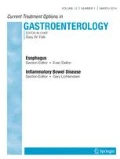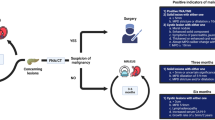Abstract
Purpose of Review
Individuals who have an increased risk for pancreatic cancer (PC) due to personal or family history may benefit from surveillance of the pancreas to increase the likelihood of early detection. This review explores current indications for PC surveillance, as well as options for surveillance modality and timing, and data regarding surveillance outcomes.
Recent Findings
Recently published data suggests that individuals undergoing surveillance who develop PC are more likely to be diagnosed with resectable disease, which improves survival. Several professional organizations have published guidelines for surveillance to help define who should have surveillance, when surveillance should be performed, and how it can be accomplished.
Summary
PC surveillance should be considered for individuals with a pathogenic variant in a PC-related gene who have an affected first- or second-degree relative and for individuals in a familial pancreatic cancer family who have an affected first-degree relative. Surveillance should begin at age 50, or 10 years before the earliest age of PC diagnosis in the family. Endoscopic ultrasound (EUS) or MRI/MRCP are both reasonable surveillance options, but EUS may be better at detecting small solid changes in the pancreas. Ideally, surveillance should be performed at expert centers in conjunction with research protocols.
Similar content being viewed by others
References and Recommended Reading
Papers of particular interest, published recently, have been highlighted as: • Of importance •• Of major importance
NCI SEER Program Cancer Stat Facts: Pancreatic Cancer. https://seer.cancer.gov/statfacts/html/pancreas.html.
• Canto MI, Harinck F, Hruban RH, Offerhaus GJ, Poley JW, Kamel I, et al. International Cancer of the Pancreas Screening (CAPS) Consortium summit on the management of patient with increased risk for familial pancreatic cancer. Gut. 2013;62:339–47. https://doi.org/10.1136/gutjnl-2012-303108 This publication was the first to establish recommendations for PC surveillance in high-risk individuals. The International CAPS Consortium has recently revised these guidelines, which are expected to be published in 2020.
•• Syngal S, Brand RE, Church JM, Giardiello FM, Hampel HL, Burt RW, et al. ACG clinical guideline: genetic testing and management of hereditary gastrointestinal cancer syndromes. Am J Gastroenterol. 2015;110:223–62. https://doi.org/10.1038/ajg.2014.435 These guidelines are the most comprehensive in addressing the questions of who, when, and how for PC surveillance in high-risk individuals.
• Stoffel EM, McKernin SE, Brand R, Canto M, Goggins M, Moravek C, et al. Evaluating susceptibility to pancreatic cancer: ASCO provisional clinical opinion. J Clin Oncol. 2019;37:153–64. https://doi.org/10.1200/JCO.18.01489 ASCO has published the most recent guidelines for genetic susceptibility to PC, including recommendations for who should undergo surveillance.
Torisu Y, Takakura K, Kinoshita Y, Tomita Y, Nakano M, Saruta M. Pancreatic cancer screening in patients with presumed branch-duct intraductal papillary mucinous neoplasms. World J Clin Oncol. 2019;10:67–74. https://doi.org/10.5306/wjco.v10.i2.67.
Pusateri AJ, Krishna SG. Pancreatic cystic lesions: pathogenesis and malignant potential. Diseases. 2018;6:50. https://doi.org/10.3390/diseases6020050.
Tanaka M, Fernandez-del Castillo C, Kamisawa T, et al. Revisions of international consensus Fukuoka guidelines for the management of IPMN of the pancreas. Pancreatology. 2017;17:738–53. https://doi.org/10.1016/j.pan.2017.07.007.
Uehara H, Nakaizumi A, Ishikawa O, Iishi H, Tatsumi K, Takakura R, et al. Development of ductal carcinoma of the pancreas during follow-up of branch duct intraductal papillary mucinous neoplasm of the pancreas. Gut. 2008;57:1561–5. https://doi.org/10.1136/gut.2007.145631.
European Study Group on Cystic Tumors of the Pancreas. European evidence-based guidelines on pancreatic cystic neoplasms. Gut. 2018;67:789–804. https://doi.org/10.1136/gutjnl-2018-316027.
Elta GH, Enestvedt BK, Sauer BG, Lennon AM. ACG Clinical Guideline: diagnosis and management of pancreatic cysts. Am J Gastroenterol. 2018;113:464–79. https://doi.org/10.1038/ajg.2018.14.
Singhi AD, Zeh HJ, Brand RE, Nikiforova MN, Chennat JS, Fasanella KE, et al. American Gastroenterological Association guidelines are inaccurate in detecting pancreatic cysts with advanced neoplasia: a clinicopathologic study of 225 patients with supporting molecular data. Gastrointest Endosc. 2016;83:1107–17. https://doi.org/10.1016/j.gie.2015.12.009.
Singhi AD, McGrath K, Brand RE, Khalid A, Zeh HJ, Chennat JS, et al. Preoperative next-generation sequencing of pancreatic cyst fluid is highly accurate in cyst classification and detection of advanced neoplasia. Gut. 2018;67:2131–41. https://doi.org/10.1136/gutjnl-2016-313586.
Giardiello FM, Offerhaus GJ, Lee DH, et al. Increased risk of thyroid and pancreatic carcinoma in familial adenomatous polyposis. Gut. 1993;34:1394–6. https://doi.org/10.1136/gut.34.10.1394.
Roberts NJ, Jiao Y, Yu J, Kopelovich L, Petersen GM, Bondy ML, et al. ATM mutations in patients with hereditary pancreatic cancer. Cancer Discov. 2012;2:41–6. https://doi.org/10.1158/2159-8290.CD-11-0194.
Thompson D, Duedal S, Kirner J, et al. Cancer risks and mortality in heterozygous ATM mutation carriers. J Natl Cancer Inst. 2005;97:813–22. https://doi.org/10.1093/jnci/dji141.
Thompson D, Easton DF. and Breast Cancer Linkage Consortium. Cancer incidence in BRCA1 mutation carriers. J Natl Cancer Inst. 2002;94:1358–65. https://doi.org/10.1093/jnci/94.18.1358.
Breast Cancer Linkage Consortium. Cancer risks in BRCA2 mutation carriers. J Natl Cancer Inst. 1999;91:1310–6. https://doi.org/10.1093/jnci/91.15.1310.
Goldstein AM, Fraser MC, Struewing JP, Hussussian CJ, Ranade K, Zametkin DP, et al. Increased risk of pancreatic cancer in melanoma-prone kindreds with p16INK4 mutations. N Engl J Med. 1995;333:970–4. https://doi.org/10.1056/NEJM199510123331504.
Aarnio M, Mecklin JP, Aaltonen LA, et al. Life-time risk of different cancers in hereditary non-polyposis colorectal cancer (HNPCC) syndrome. Int J Cancer 1995: 64: 430-433. Doi:
Jones S, Hruban RH, Kamiyami M, et al. Exomic sequencing identifies PALB2 as a pancreatic cancer susceptibility gene. Science. 2009;324:217. https://doi.org/10.1002/ijc.2910640613.
Hearle N, Schumacher V, Menko FH, Olschwang S, Boardman LA, Gille JJ, et al. Frequency and spectrum of cancers in the Peutz-Jeghers syndrome. Clin Cancer Res. 2006;12:3209–15. https://doi.org/10.1158/1078-0432.CCR-06-0083.
Birch JM, Alston RD, McNally RJ, Evans DG, Kelsey AM, Harris M, et al. Relative frequency and morphology of cancers in carriers of germline TP53 mutations. Oncogene. 2001;20:4621–8. https://doi.org/10.1038/sj.onc.1204621.
Shelton CA, Umapathy C, Stello K, Yadav D, Whitcomb DC. Hereditary pancreatitis in the United States: survival and rates of pancreatic cancer. Am J Gastroenterol. 2018;113:1376. https://doi.org/10.1038/s41395-018-0194-5.
NCCN clinical practice guidelines in oncology: genetic/familial high-risk assessment: breast and ovarian. Version 3.2019. January 18, 2019. https://www.nccn.org/professionals/physician_gls/pdf/genetics_screening.pdf accessed 11 June 2019.
Grant RC, Slander I, Connor AA, et al. Prevalence of germline mutations in cancer predisposition genes in patients with pancreatic cancer. Gastroenterology. 2015;148:556–64. https://doi.org/10.1053/j.gastro.2014.11.042.
Hu C, Hart SN, Bamlet WR, Moore RM, Nandakumar K, Eckloff BW, et al. Prevalence of pathogenic mutations in cancer predisposition genes among pancreatic cancer patients. Cancer Epidemiol Biomarkers Prev. 2016;25:207–11. https://doi.org/10.1158/1055-9965.EPI-15-0455.
Shindo K, Yu J, Suenaga M, Fesharakizadeh S, Cho C, Macgregor-Das A, et al. Deleterious germline mutations in patients with apparently sporadic pancreatic adenocarcinoma. J Clin Oncol. 2017;35:3382–90. https://doi.org/10.1200/JCO.2017.72.3502.
Brand R, Borazanci E, Speare V, et al. Prospective study of germline genetic testing in incident cases of pancreatic adenocarcinoma. Cancer. 2018;124:3520–7. https://doi.org/10.1002/cncr.31628.
Yurgelun MB, Chittenden AB, Morales-Oyarvide V, Rubinson DA, Dunne RF, Kozak MM, et al. Germline cancer susceptibility variants, somatic second hits, and survival outcomes in patients with resected pancreatic cancer. Genet Med. 2019;21:213–23. https://doi.org/10.1038/s41436-018-0009-5.
Brand RE, Lerch MM, Rubinstein WS, Neoptolemos JP, Whitcomb DC, Hruban RH, et al. Advances in counselling and surveillance of patients at risk for pancreatic cancer. Gut. 2007;56:1460–9. https://doi.org/10.1136/gut.2006.108456.
Klein AP, Brune KA, Petersen GM, et al. Prospective risk of pancreatic cancer in familial pancreatic cancer kindreds. Cancer Res. 2004;64:2634–8. https://doi.org/10.1158/0008-5472.CAN-03-3823.
Brune KA, Lau B, Palmisano E, Canto M, Goggins MG, Hruban RH, et al. Importance of age of onset in pancreatic cancer kindreds. J Natl Cancer Instit. 2010;102:119–26. https://doi.org/10.1093/jnci/djp466.
• Abe T, Blackford AL, Tamura K, Ford M, McCormick P, Chuidian M, et al. Deleterious germline mutations are a risk factor for neoplastic progression among high-risk individuals undergoing pancreatic surveillance. J Clin Oncol. 2019;37:1070–80. https://doi.org/10.1200/JCO.18.01512 The data in this publication highlights the importance of knowing gene PV status for individuals undergoing PC surveillance. It also lays framework for beginning to understand which high-risk groups may most benefit from surveillance.
Canto MI, Hruban RH, Fishman EK, et al. Frequent detection of pancreatic lesions in asymptomatic high-risk individuals. Gastroenterology. 2012;142:796–804. https://doi.org/10.1053/j.gastro.2012.01.005.
• Bartsch DK, Slater EP, Carrato A, Ibrahim IS, Guillen-Ponce C, Vasen HF, et al. Refinement of screening for familial pancreatic cancer. Gut. 2016;65:1314–21. https://doi.org/10.1136/gutjnl-2015-311098 This study clearly established that high-risk PC lesions are extremely rare before age 50 and provides data to support the recommendation that screening begin at age 50 in most high-risk individuals.
The Cancer of the Pancreas Screening-5 Study (CAPS5). https://clinicaltrials.gov/ct2/show/NCT02000089. Accessed 25 Sep 2019.
A study of IMMRayTM PanCan-d test for early detection of pancreatic cancer in high-risk groups. https://clinicaltrials.gov/ct2/show/NCT03693378. Accessed 25 Sep 2019.
• Harinck F, Konings IC, Klujit I, et al. A multicentre comparative prospective blinded analysis of EUS and MRI for screening of pancreatic cancer in high-risk individuals. Gut. 2016;65:1503–13. https://doi.org/10.1136/gutjnl-2014-308008 The data from this study suggests that either MRI or EUS can be used as a surveillance tool for individuals at increased risk for PC, but that EUS is better at detecting small solid lesions, which has implications for early detection of PC.
Corral JE, Das A, Bruno MJ, Wallace MB. Cost-effectiveness of pancreatic cancer surveillance in high-risk individuals: an economic analysis. Pancreas. 2019;48:526–36. https://doi.org/10.1097/MPA.0000000000001268.
Vasen H, Ibrahim I, Ponce CG, Slater EP, Matthäi E, Carrato A, et al. Benefit of surveillance for pancreatic cancer in high-risk individuals: outcome of long-term prospective follow-up studies from three European expert centers. J Clin Oncol. 2016;34:2010–9. https://doi.org/10.1200/JCO.2015.64.0730.
Paiella S, Salvia R, De Pastena M, et al. Screening/surveillance programs for pancreatic cancer in familial high-risk individuals: a systematic review and proportion meta-analysis of screening results. Pancreatology. 2018;18:420–8. https://doi.org/10.1016/j.pan.2018.04.002.
Canto MI, Kerdsirichairat T, Yeo CJ, Hruban RH, Shin EJ, Almario JA, et al. Surgical outcomes after pancreatic resection of screening-detected lesions in individuals at high risk for developing pancreatic cancer. J Clin Oncol. 2019: epub ahead of print:1–10. https://doi.org/10.1007/s11605-019-04230-z.
•• Canto MI, Almario JA, Schulick RD, Yeo CJ, Klein A, Blackford A, et al. Risk of neoplastic progression in individuals at high risk for pancreatic cancer undergoing long-term surveillance. Gastroenterol. 2018;155:740–51. https://doi.org/10.1053/j.gastro.2018.05.035 This prospective data illustrates that high-risk individuals who are compliant with PC surveillance recommendations have a higher likelihood of being diagnosed with high-risk precursor lesions or resectable PC. This study also indicates an improved survival for individuals with screen-detected PC.
Author information
Authors and Affiliations
Corresponding author
Ethics declarations
Conflict of Interest
Beth Dudley and Randall E. Brand declare no conflict of interest.
Human and Animal Rights and Informed Consent
This article does not contain any studies with human or animal subjects performed by any of the authors.
Additional information
Publisher’s Note
Springer Nature remains neutral with regard to jurisdictional claims in published maps and institutional affiliations.
This article is part of the Topical Collection on Genetics in Gastroenterology Practice
Rights and permissions
About this article
Cite this article
Dudley, B., Brand, R.E. Pancreatic Cancer Surveillance: Who, When, and How. Curr Treat Options Gastro 17, 681–691 (2019). https://doi.org/10.1007/s11938-019-00247-0
Published:
Issue Date:
DOI: https://doi.org/10.1007/s11938-019-00247-0




